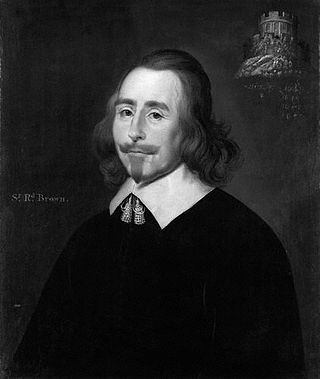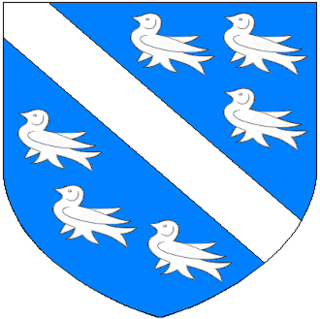Related Research Articles
Viscount Newcomen, of Mosstown in the County of Longford, was a title in the Peerage of Ireland. It was created in 1803 for Charlotte Gleadowe-Newcomen, Baroness Newcomen. She had already been made Baroness Newcomen, of Mosstown in the County of Longford, in 1800, also in the Peerage of Ireland. She was the wife of William Gleadowe-Newcomen, who represented County Longford in both the Irish and British House of Commons. In 1781 he was created a Baronet, of Carrickglass in the County of Longford, in the Baronetage of Ireland. Lady Newcomen was the only child and heiress of Edward Newcomen, of Carrickglass, County Longford, grandson of Sir Robert Newcomen, 6th Baronet, of Kenagh. At the extinction of the Newcomen baronetcy in 1789, the substantial family estates devolved on the future Lady Newcomen. Her husband was born William Gleadowe, but assumed at the time of their marriage the additional surname of Newcomen. Sir William and Lady Newcomen were both succeeded by their son, the second Baronet and second Viscount. He sat as Member of Parliament for County Longford in the British House of Commons. The titles became extinct on his death in 1825.

There have been ten baronetcies created for persons with the surname Browne, six in the Baronetage of Great Britain, three in the Baronetage of Ireland and one in the Baronetage of Nova Scotia. Only one creation is extant as of 2010. Three of the creations were for members of the Browne family headed by the Viscount Montagu.
Nineteen baronetcies have been created for persons with the surname Hamilton, eight in the Baronetage of Nova Scotia, one in the Baronetage of England, five in the Baronetage of Ireland, one in the Baronetage of Great Britain and four in the Baronetage of the United Kingdom. As of 2008 two creations are extant, two are dormant, two are either extinct or dormant and twelve extinct.
There have been two baronetcies created for people with the surname Heathcote, both in the Baronetage of Great Britain and both created in 1733. The holders of the first creation were later elevated to the peerage as Baron Aveland and Earl of Ancaster, which titles are now extinct. However, both baronetcies are extant as of 2008.

Simon Luttrell, 1st Earl of Carhampton, was an Anglo-Irish politician who sat in the House of Commons from 1754 to 1780.
Sir Maurice Eustace, 1st Baronet was an Irish gentleman, the only holder of the Eustace Baronetcy of Castle Martin in County Kildare, which was created for him in the Baronetage of Ireland on 23 December 1685.

The Hales Baronetcy, is a title in the Baronetage of England. There were three Hales baronetcies. The oldest was created in 1611 for Edward Hales. He was a member of a Kent family. The second was created in 1660 for Robert Hales, MP for Hythe 1659, also of a Kent family. The third was created in 1660 for John Hales of Coventry, co. Warwick.
Sir Francis Blundell, 3rd Baronet was an Irish baronet and politician.

The Newcomen Baronetcy, of Kenagh in the County of Longford, was a title in the Baronetage of Ireland. It was created on 30 December 1623 for Robert Newcomen. Born in London, the third son of Charles Newcomen and Jane Nightingale, Robert had come to Ireland in the late sixteenth century. He settled at Keenagh in County Longford, where he became a substantial landowner, and sat in the Irish House of Commons for Kilbeggan. By his first wife Katherine Molyneux, daughter of Sir Thomas Molyneux, Chancellor of the Exchequer of Ireland and Catherine Stabeort, he had twenty-one children, including the second, third and fourth Baronets. The fifth baronet was a Jacobite soldier. The sixth, seventh and eighth Baronets also represented County Longford in the Irish House of Commons. The eighth Baronet also represented Longford Borough in Parliament. The title became extinct on his death on 27 April 1789.
Sir Charles Kemeys, 4th Baronet (1688–1735) was a British Tory politician who sat in the House of Commons between 1713 and 1734.
William Dongan, 1st Earl of Limerick was an Irish Jacobite solider and peer.
Sir Henry Bond, 2nd Baronet was an English Jacobite.
Sir Robert Newcomen, 6th Baronet was an Anglo-Irish politician.
Sir Patrick Trant, known as Sir Patrick Trant, 1st Baronet between 1686 and 1691, was an Anglo-Irish politician and Jacobite.
Sir Edward Tyrrell, 1st Baronet was an Anglo-Irish landowner and Jacobite.
Sir William Hurly, 3rd Baronet was an Anglo-Irish Jacobite politician.
Sir John Fitzgerald, 2nd Baronet was an Irish Jacobite politician and soldier.
Sir Gregory Byrne, 1st Baronet was an Irish Jacobite soldier and politician.
Sir John Everard, 3rd Baronet was an Irish Jacobite soldier and politician.
Simon Luttrell was an Irish Jacobite politician and soldier.
References
- ↑ NEWCOMEN, Hon. Thomas. Officers of the Jacobite Armies, Centre for Robert Burns Studies, University of Glasgow. Retrieved 17 February 2023.
- ↑ The Complete Baronetage - https://archive.org/details/completebaroneta01coka/page/254/mode/2up
- ↑ Messrs. John and Sir Bernard Burke, A Genealogical and Heraldic History of the Extinct and Dormant Baronetcies of England, Ireland, and Scotland (J. R. Smith, 1844), p.612.
- ↑ Ó Ciardha, Éamonn (October 2009). "Luttrell, Simon". Dictionary of Irish Biography. Retrieved 17 February 2023.